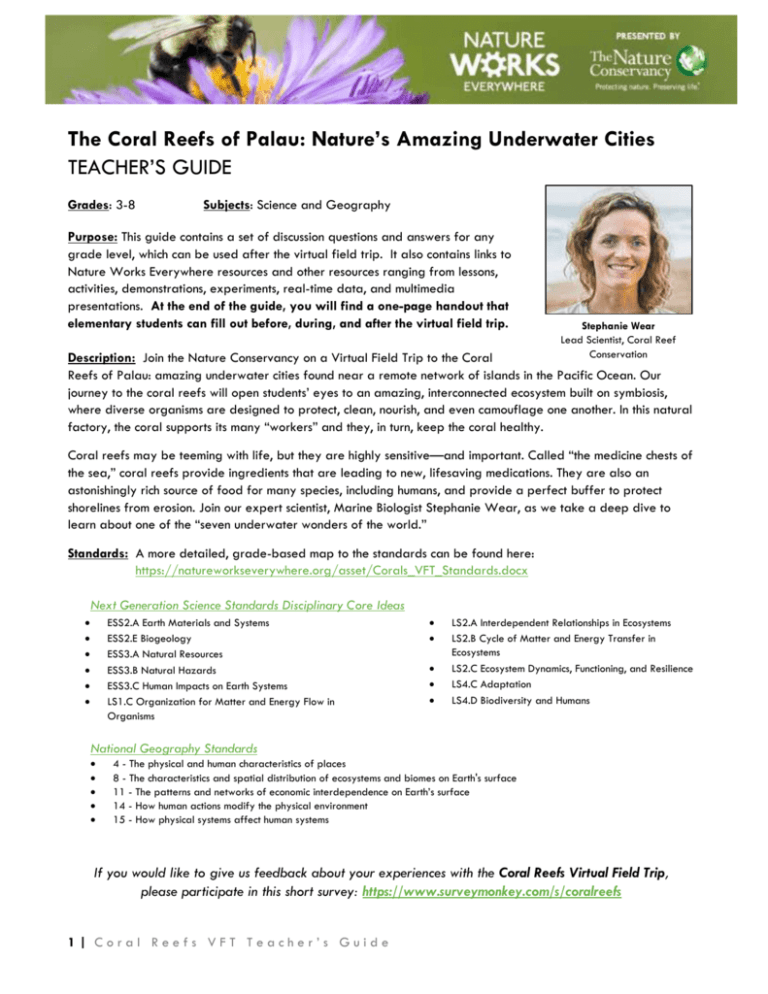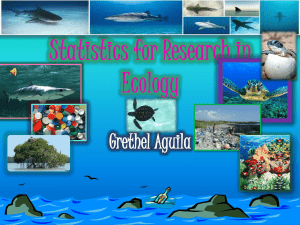Word - Nature Works Everywhere
advertisement

The Coral Reefs of Palau: Nature’s Amazing Underwater Cities TEACHER’S GUIDE Grades: 3-8 Subjects: Science and Geography Purpose: This guide contains a set of discussion questions and answers for any grade level, which can be used after the virtual field trip. It also contains links to Nature Works Everywhere resources and other resources ranging from lessons, activities, demonstrations, experiments, real-time data, and multimedia presentations. At the end of the guide, you will find a one-page handout that elementary students can fill out before, during, and after the virtual field trip. Stephanie Wear Lead Scientist, Coral Reef Conservation Description: Join the Nature Conservancy on a Virtual Field Trip to the Coral Reefs of Palau: amazing underwater cities found near a remote network of islands in the Pacific Ocean. Our journey to the coral reefs will open students’ eyes to an amazing, interconnected ecosystem built on symbiosis, where diverse organisms are designed to protect, clean, nourish, and even camouflage one another. In this natural factory, the coral supports its many “workers” and they, in turn, keep the coral healthy. Coral reefs may be teeming with life, but they are highly sensitive—and important. Called “the medicine chests of the sea,” coral reefs provide ingredients that are leading to new, lifesaving medications. They are also an astonishingly rich source of food for many species, including humans, and provide a perfect buffer to protect shorelines from erosion. Join our expert scientist, Marine Biologist Stephanie Wear, as we take a deep dive to learn about one of the “seven underwater wonders of the world.” Standards: A more detailed, grade-based map to the standards can be found here: https://natureworkseverywhere.org/asset/Corals_VFT_Standards.docx Next Generation Science Standards Disciplinary Core Ideas ESS2.A Earth Materials and Systems ESS2.E Biogeology ESS3.A Natural Resources ESS3.B Natural Hazards ESS3.C Human Impacts on Earth Systems LS1.C Organization for Matter and Energy Flow in Organisms LS2.A Interdependent Relationships in Ecosystems LS2.B Cycle of Matter and Energy Transfer in Ecosystems LS2.C Ecosystem Dynamics, Functioning, and Resilience LS4.C Adaptation LS4.D Biodiversity and Humans National Geography Standards 4 - The physical and human characteristics of places 8 - The characteristics and spatial distribution of ecosystems and biomes on Earth's surface 11 - The patterns and networks of economic interdependence on Earth’s surface 14 - How human actions modify the physical environment 15 - How physical systems affect human systems If you would like to give us feedback about your experiences with the Coral Reefs Virtual Field Trip, please participate in this short survey: https://www.surveymonkey.com/s/coralreefs 1| Coral Reefs VFT Teacher’s Guide Discussion Questions: You can use or adapt these questions for a follow-up discussion with your students after viewing the virtual field trip. 1. Where can you find coral reefs around the world? Answer: Coral reefs form in warmer waters near the equator and between the Tropic of Cancer and the Tropic of Capricorn. 2. Describe how coral reefs are like big cities. Answer: Coral reefs have a lot of activity going on in them at all times. Twenty-five percent of all of marine life lives on a coral reef. Reef structures serve as homes and restaurants for the creatures found there. 3. What is coral? Answer: Coral is an animal that has a hard skeleton filled with soft, fleshy parts called polyps. The polyps are like mini sea anemones. When polyps die, they leave behind their skeletons and eventually large reefs build up from these skeletons. 4. Describe the parts of a coral reef food web. Answer: Just like on land, there are producers like phytoplankton, sea weed, sea grass, and kelp that can make food from sunlight. There are primary consumers or herbivores that eat the producers; some examples of herbivores are sea turtles, manatees, shrimp, and some fish. Secondary consumers are carnivores like sharks and sea snakes that eat primary consumers. 5. What does symbiosis mean? Answer: Symbiosis is when two different organisms live close together and interact in some way. This interaction can be positive or negative. 6. Define mutualism and parasitism. Answer: Mutualism is a type of symbiosis where both organisms benefit. Parasitism is an interaction where one organism benefits and the other organism is harmed. 7. Give an example of mutualism and explain how the symbiotic relationship works. Answer: a. Zooxanthellae and Corals: Zooxanthellae help corals by providing food for the corals and corals help zooxanthellae by giving them a place to live. Corals also provide zooxanthellae with carbon dioxide that they can use during photosynthesis. b. Herbivores and Corals: Some fish that are herbivores eat seaweed that is growing in competition with the coral. Corals send out chemical signals to the fish and the fish come and eat the seaweed, which protects the corals. c. Cleaner Stations: Larger fish and eels come to cleaners stations where small fish and shrimp “clean” them by eating parasites and dead tissues. This helps keep the larger organisms healthy and the smaller organisms get a meal. 8. List and describe some of the things that coral reefs do for people. Answer: a. Medicine Chests of the Sea: Corals and some of the organisms that live in and around the reefs possess chemicals that can be used for communication or defense. In some cases, these chemicals have been found to have medicinal properties and can be repurposed and used in the treatment of a wide variety of illnesses ranging from cancer to HIV to Alzheimer’s disease. 2 |C o r a l R e e f s V F T T e a c h e r ’ s G u i d e b. Coastal Protection: Reefs act as a barrier and help to calm or buffer waves that could be destructive to property on the coasts. They help prevent the coastline from eroding and keep waves from surging onto land and flooding property. c. Habitat for Fish: Reefs provide a home for a wide variety of organisms, including fish that people eat. 9. In what ways are coral reefs sensitive? Answer: Coral reefs are sensitive to temperature change. Reef-forming corals live in waters that are not too hot and not too cold. Slight increases in temperature can cause the corals to expel their zooxanthellae. This is called coral bleaching because the zooxanthellae give corals their color. When the zooxanthellae leave, the corals appear white or bleached. If the water temperature cools, the zooxanthellae will come back, however, if the zooxanthellae leave for too long, the corals can die. Corals are also sensitive to pollution and overfishing. Lastly, ocean acidification, caused by the increased uptake of carbon dioxide in the ocean, can greatly diminish the ability of corals to build new structures and can even cause coral skeletons to weaken or dissolve. 10. What are some ways that the people of Palau have worked to save their reefs and protect their ocean habitats? Answer: Palauans created the world’s first shark sanctuary and have banned all commercial fishing from their waters. Only Palauans are able to fish their waters using low impact, traditional fishing methods. 11. Describe some ways that people are working to protect reefs worldwide. Answer: People are learning how to grow corals in nurseries and then using those corals to restore reefs elsewhere. 12. What are some things that you can do to help coral reefs stay healthy and strong? Answer: You can be mindful of the fish that you eat and make sure to eat fish that are sustainably harvested by using websites like NOAA’s Fishwatch (www.fishwatch.gov ) to learn which species are okay to eat. Don’t purchase jewelry made with coral pieces. If you go snorkeling or diving near reefs, don’t touch the corals and be careful not to step on them or hit them with your feet. Don’t litter – it might eventually end up in our oceans. Conserve water – the less wastewater you generate, the less likely that wastewater will end up in the ocean. Teach other people what you have learned about corals. Related Nature Works Everywhere Resources: The following lesson plans and videos can be used to supplement the virtual field trip. The Need is Mutual: The Importance of Biological Interactions Grade Levels: 6-8 https://www.natureworkseverywhere.org/#resources/527be785c4b 7765f18581cb7 Organisms have a variety of relationships. In this lesson, students learn to categorize relationships, like symbiosis, between organisms. To reinforce the lesson, examples from coral reefs are presented. There are several extensions for this lesson plan. © Ian Shive The Nature Conservancy 3 |C o r a l R e e f s V F T T e a c h e r ’ s G u i d e Other Related Resources Ocean Acidification Activities and Experiments Below is a summary of a few demonstrations or simple experiments you can do with students. The URLs provided come from lesson plans with more detailed information. Use beakers with differing concentrations of acid (in this case – vinegar). Put calcium tablets, old-style chalk, egg shells, etc. in the beakers and watch the change over time. The pH of the solution can be measured and the items can be weighed as time passes. This demonstrates how organisms with calcium carbonate shells can dissolve in the presence of increased acidity. o http://www.cisanctuary.org/ocean-acidification/PDFsWorkshopPage/Hands_on_acivities/Marine_Osteoporosis/marineos.pdf o http://www.cisanctuary.org/ocean-acidification/PDFs-WorkshopPage/Hands_on_acivities/OA_Shells.pdf Put red cabbage juice or bromothymol blue indicators in a beaker and blow into them with straw (adding CO 2). The indicator will change color as CO2 increases. This demonstrates how the ocean takes up carbon dioxide. o http://monitor.noaa.gov/education/pdfs/rov_ocean_acidification.pdf Put dry ice in a beaker with bromothymol blue. As the dry ice sublimates, the carbon dioxide gas will change the color of the indicator from blue to green to yellow. This illustrates how carbon dioxide can be taken up by seawater. o http://www.cisanctuary.org/ocean-acidification/PDFsWorkshopPage/Hands_on_acivities/OA_dry_ice_demo.pdf Classroom Resources (All Grades) NOVA Next: Palau’s Improbably Healthy Coral Reefs, by Joshua Sokol http://www.pbs.org/wgbh/nova/next/nature/acidic-coral-refugia/ NOAA Education Coral Ecosystems Collection – background information, lessons and activities, multimedia http://www.education.noaa.gov/Marine_Life/Coral_Ecosystems.html NOAA Education Ocean Acidification Collection – background information, lessons and activities, multimedia http://www.education.noaa.gov/Ocean_and_Coasts/Ocean_Acidification.html Google Earth Oceans Street View – Explore coral reefs using Google https://www.google.com/maps/views/streetview/oceans?gl=us Google Earth Underwater Streetview for World Oceans Day 2015 http://google-latlong.blogspot.com/2015/06/explore-life-beneath-waves-in-honor-of.html NOAA Coral Reef Ecosystem Poster – download a PDF of a poster http://coralreef.noaa.gov/education/educators/resourcecd/posters/ Real-time Data (Middle School to High School Level) Data in the Classroom – Ocean Acidification and Coral Bleaching Modules http://dataintheclassroom.noaa.gov/ NOAA View Coral Bleaching -http://www.nnvl.noaa.gov/view/#CDHW Ocean Acidification - http://www.nnvl.noaa.gov/view/#ACID Visualizations and Imagery (Middle School to High School Level) Ocean Acidification Animation http://www.nnvl.noaa.gov/MediaDetail.php?MediaID=165&MediaTypeID=2 Bleaching Stress Visualization for Indo-Pacific Corals http://www.nnvl.noaa.gov/MediaDetail.php?MediaID=490&MediaTypeID=1 Bleaching Conditions 2014 http://www.nnvl.noaa.gov/MediaDetail2.php?MediaID=1648&MediaTypeID=1 Science Bulletins – Coral Reefs in Hot Water https://www.youtube.com/watch?v=RTcBFME4_bU&list=PL03468DEB0456E448&index=21 4 |C o r a l R e e f s V F T T e a c h e r ’ s G u i d e The Coral Reefs of Palau Virtual Field Trip Log BEFORE AFTER I know that…________________________________ I want to know more about…_____________ _________________________________________________ _________________________________________________ I wonder if…_________________________________ My favorite part was …____________________ _________________________________________________ _________________________________________________ I hope that…_________________________________ I learned that…______________________________ _________________________________________________ _________________________________________________ Imagine you are in Palau – what would you be doing? On the left, draw a “selfie” of yourself on your trip. Rate this virtual field trip:





